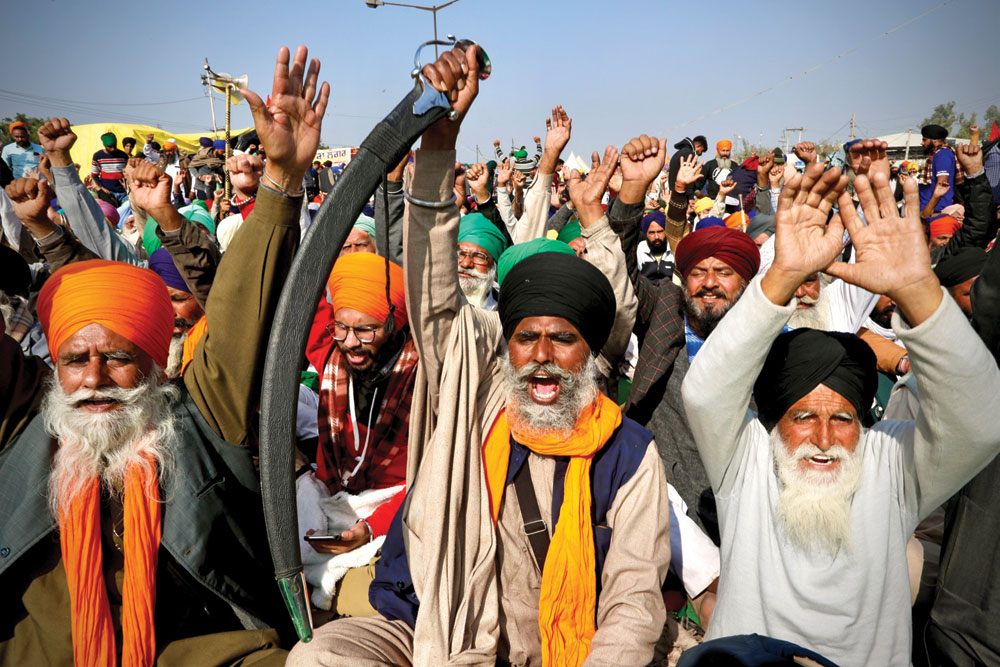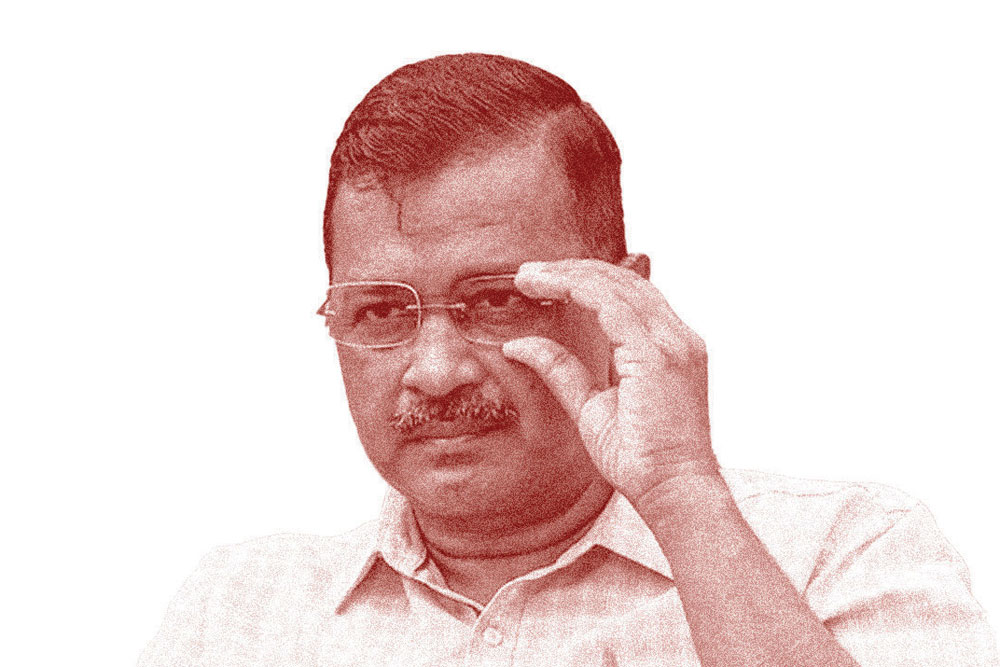The Order of Disorder
The Prime Minister’s security breach in Punjab highlights the increasingly extra-parliamentary nature of protest
 Siddharth Singh
Siddharth Singh
 Siddharth Singh
Siddharth Singh
 |
14 Jan, 2022
|
14 Jan, 2022
/wp-content/uploads/2022/01/PM1.jpg)
Prime Minister Narendra Modi’s convoy stuck on a flyover near Ferozepur in Punjab, January 5
FOR THE GROUP of farmers in Piareana village of Punjab who blocked a flyover on January 5th, their sit-in was a normal thing. The agitation that began in September 2020 may have been ended by the umbrella organisation of protesting farmers’ unions but for this particular group—the Bharti Kisan Union (Krantikari), or BKU(K)—their intended target, Prime Minister Narendra Modi, was a legitimate target. The prime minister, who was on his way to the National Martyrs Memorial at Hussainiwala, was forced to return without completing his visit. Since then, there has been furious all-round commentary. Ranged on one side is the opinion that it was just desserts: the farmers of Punjab were only highlighting their disapproval of Modi. On the other side, equally extreme opinion has it that the prime minister’s life was in danger, if not his being an actual target, given the place where he was held up, not far from the border with Pakistan.
What was not acknowledged in the welter of commentary was the fact of the increasingly extra-parliamentary nature of protest and how the incident involving the prime minister marked another redline being breached, the fourth in the last two years or so. If one draws a line from the Shaheen Bagh protests that began in December 2019 and includes the farmers’ agitation, the Red Fort vandalism on January 26th, 2021 and the incident at Piareana, the trend and tempo of protests has gone up. Each succeeding agitation has been more intense, to the point that what transpired last week was not just unprecedented but marked a qualitatively different challenge to authority: even the head of government could be cornered if the protesters desired.
There are many unanswered and disturbing questions that these incidents pose. Has the nature of disorder in India changed in the last two years? Will the rising tempo of protests lead to a systemic crisis? Some answers can be gleaned from historical parallels from India’s history; others are more or less in the realm of prophecy.
The first thing to note from these protests is that it is a paradox of sorts that political disorder in India has moved away from its periphery to its centre. Until a decade ago, violence and political disorder were largely restricted to states like Jammu and Kashmir (J&K), parts of the Northeast and the Maoist ‘Red Corridor’. The writ of the state did not run in these places even if violence in J&K and Maoist areas had peaked a while earlier. This violence was explicable in many ways: geographic isolation, the sway of extremist ideologies, religion as a political force and more were at work in these areas. The common refrain—erroneous, of course—was that poverty and isolation made a perfect recipe for violence.
The current disturbances, in contrast, are taking place in and around the centre of power in India. All are against a democratic exercise of authority by government and Parliament. In the Shaheen Bagh protest, the protestors wanted the Citizenship (Amendment) Act (CAA) repealed. This was a law that did not affect Indian citizens—of any religion—but it fell foul of India’s politics by numbers where religious communities don’t build coalitions with other communities but want to assert themselves as vote banks on the basis of numerical strength. Something similar was at work in the case of the farm reform laws. Here, unlike the Shaheen Bagh protest, the scale and duration of the agitation forced the Government’s hand.
In both cases, India’s intellectuals—and more importantly, activists, civil society and NGOs—held the exercise of Parliament’s authority to be illegitimate. The claim in these cases being that extra-parliamentary approval was necessary before the laws could be passed. This, in effect, renders Parliament nothing more than a permissions office while legislation is decided on the roads. Were it not for the robustness of India’s institutions, one could—pardon the expression—even describe its democracy as a ‘hybrid democracy’. Hybrid not in the usual political science meaning where unelected institutions hold elected representatives to ransom but where special interests decide the upper limit of what Parliament and government can do.
THIS METHOD OF extra-parliamentary mobilisation is not exactly new to India. In the 1970s, the opposition was in a similar situation as it is today. A popular prime minister was unassailable politically. Electorally, the opposition had very little traction and resorted to agitations. If one examines the history of that period dispassionately, these agitations were born of political frustration. There was a political economy element to be sure. India had seen crop failures and inflation remained unchecked. The 1973 oil crisis added fuel to the fire. Finally, the serving prime minister made errors of judgement.
That, however, is where the parallel comes to an end.
Unlike the 1970s, where parliamentary and political opposition had a major role in organising agitations, the 21st century version has been outsourced to activists, civil society and intellectuals. There is a neat division of labour at work here. The activists organise while intellectuals provide ideological foil and legitimacy. Unlike parliamentary opposition—amenable to reason and bound by the hard political limits of what is acceptable and what is not—agitations organised by activists have no limits and can reach dangerous levels of discontent.
The danger in 2022 is that this mix of desperation and despondency can precipitate a crisis. As emboldened activist groups mobilise more, the government’s energies will be spent on managing the fallout. Or it may just avoid any damaging political fallout. The real loss will be for India and its economy
The best example of this trend is Punjab where, after blocking the prime minister, the leader of BKU(K), Surjit Singh Phul, issued a ‘victory’ message to his supporters and celebrated the fact that Bharatiya Janata Party (BJP) supporters were not allowed to reach the venue of the prime minister’s meeting in Ferozepur. All this came after the Samyukt Kisan Morcha, the umbrella organisation of the agitators, had clearly stated that the protest was over. But once unleashed, there is no way to put the genie back in the bottle. Now, virtually any farmer in Punjab can be mobilised in the name of ‘justice’. During the agitation, farmers’ unions went as far as to demand the cancellation of power purchase agreements (PPAs) made by the state government, a step that would prove deleterious to Punjab’s economic future if implemented. The idea that PPAs and amendments to the Electricity Act are unjust is of NGO provenance: no political party—barring some unpredictable elements within them—is likely to raise such issues that can lead to unmanageable disorder. But that is exactly what has come to pass in Punjab.
Normally, such protests and political activities are the domain of political parties. For various reasons, these parties now lack the necessary traction to mobilise. The matter is also one of circumstances. The party with the greatest ability to mobilise and the political resources necessary to do so is now the ruling party. Most parties that can counter BJP are regional in nature and can only mobilise in states where they are in power. Thus, it is not surprising that the farmers’ agitation was wholly under the influence of activists and the various BKU factions that had become moribund decades ago.
Even on this score, activists and intellectuals blame BJP for the loss of political influence of opposition parties. The refrain being that BJP is ‘too strong’ for rival parties to gain influence with the electorate. It is another matter that since 2014, BJP has lost power in states where it was considered to be dominant (Maharashtra) or has remained in power with a narrow majority (Madhya Pradesh). In others, it has been ousted (Rajasthan, Jharkhand, Chhattisgarh). West Bengal is the exemplar of the limits imposed by a diverse polity on what BJP can do. Yet, the political analogue of ‘blaming the victim’ continues to have currency. Political scientists have a fancy expression for it: weakening of political competition.
IN ESTABLISHED DEMOCRACIES across the world, it is not unusual to see a single party remain in power for multiple terms. In Britain, Conservative and Labour governments have lasted for a decade or more multiple times since 1950. In the US, presidents from both parties have lasted two terms on many occasions. A similar story can be told of many European democracies. In India as well, Congress had remained in power for decades on end.
But something changed in India after the defeat of the Rajiv Gandhi Government in 1989. For nearly three decades, unwieldy coalitions ruled India. Along with this, power fragmented across different institutions and more cohesive ones like the judiciary often cast the determining vote in governance issues. Globally, this was the time when there was a ‘Third Wave’ of democracy when erstwhile dictatorships turned democratic overnight. By the first decade of 21st century, single-party governments in India seemed a historical artefact. Along with the change in this political climate came a change in intellectual descriptions of democracy. “Fragmentation of power” was thought to be the best safeguard against tyranny, a form of government independent India had never known. The fact that India had been ruled by a single party for the better part of its independent existence was forgotten. Matters have come to such a pass that any single-party government with a strong parliamentary majority is likely to be viewed as a threat to democracy.
This casts Indian democracy in a very different light. There is a strong upper limit beyond which autonomous political actors like activists and civil society will not let any government carry out its programme. These actors are used to involvement in political tasks for them to let a ‘powerful’ government carry out its agenda without obstruction. In a diverse country like India marred by sub-nationalism, this is easy to do.
The areas where maximum obstruction is likely are the ones where special interests are organised. From this perspective, it is instructive that the farmers’ agitation succeeded as it was limited to the rich ones from Punjab and other Green Revolution areas in northern India. Rolling back the repeal of Article 370 would have been a dangerous possibility had it not been for the extraordinary security measures put in place by the Government. But one area where activists are likely to engage in resistance is any restructuring of economic bottlenecks, such as labour laws, efforts at liberalising factor markets and, what Marxists describe as “capital accumulation”. This also means that conglomerates are likely to be targets of such activist and civil society coalitions.

This situation makes for an interesting contrast between the erstwhile second United Progressive Alliance (UPA II) Government and the current BJP-led one. Back in 2013, on the eve of the 2014 General Election, the UPA II Government was said to be in the grip of the infamous ‘policy paralysis’. Civil society and activists had ensured that key infrastructure projects could not take off due to environmental policy blocks. Similarly, the 2013 land acquisition law was designed to ensure that PPP projects and industrialisation were all but stalled. Even issues entirely in the Centre’s hands—such as letting FDI in the retail sector—were sought to be passed off to the states for approval. In all this, powerful activist groups and civil society’s demands had been internalised by the UPA II Government.
The present Government—which has kept such pernicious influences away from governance—is facing the heat from outside where these actors have now mobilised diverse groups. In the last six years, infrastructural development—earlier hostage to environmentalists—has grown by leaps and bounds. But that which can further economic growth, such as the repealed farm laws, is now hostage to these groups from the outside. It is now a foregone conclusion that in the remaining two-and-a-half years of the present Government, only those reforms will be carried out that do not have any scope of activist-led mobilisation. It is a travesty that intellectuals bemoaned the absence of economic reforms from the BJP-led Government but when substantial reforms were carried out, they were defeated on specious political grounds.
It is interesting to speculate what these groups will do after the results of the five Assembly elections this year are declared. It goes without saying that the biggest prize for any political party is Uttar Pradesh (UP). In case BJP manages to retain its hold on UP, a ‘two-track’ outcome is likely. Activist groups are likely to get even more desperate and organise protests at any available opportunity. Political parties, on the other hand, are likely to view the results with despondency: UP, if it is held, will impart a positive momentum to BJP for 2024. Coalition-building efforts will continue but with a sense of resignation.
The danger in 2022 is that this mix of desperation and despondency can precipitate a crisis. As emboldened activist groups mobilise more, increasingly the Government’s energies will be potentially spent on managing the fallout. Another possibility is that the Government may just avoid any damaging political fallout by not taking steps that can precipitate protests. In either scenario, the real loss will be for India and its economy.
In the last two years it has become something of an intellectual fashion to describe India as something less-than-a-democracy. Various catchy expressions have been coined: ‘partially free’ democracy, ‘electoral autocracy’, ‘anocracy’ and more. But the events of the last two years, in which the Government has not taken a single coercive step to rein in protests by special interests, give a different complexion to the situation. Contemporary India is better described as a contest between order and disorder instead of the sterile debate about whether it is a democracy or an authoritarian country. A Government that took no action against rampaging farmers who invaded the Red Fort and that was forced to roll back the most ambitious economic reforms in a decade can hardly be called authoritarian.

/wp-content/uploads/2025/01/Cover_Kumbh.jpg)












More Columns
The lament of a blue-suited social media platform Chindu Sreedharan
Pixxel launches India’s first private commercial satellite constellation V Shoba
What does the launch of a new political party with radical background mean for Punjab? Rahul Pandita